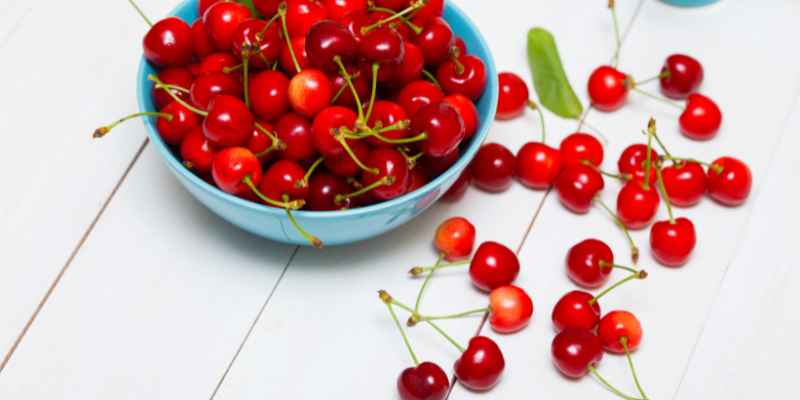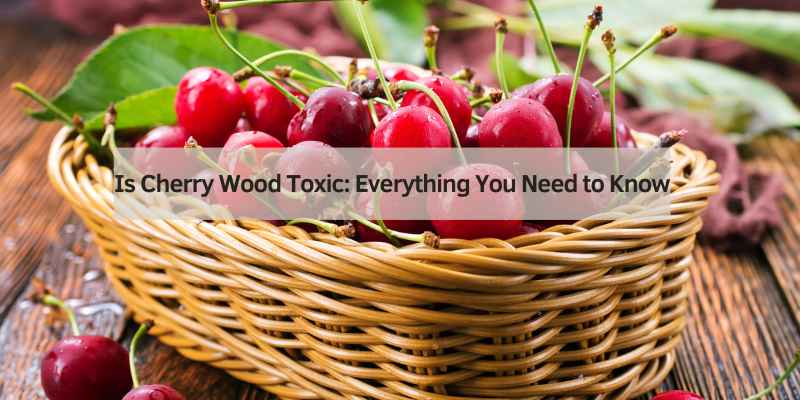Cherry wood itself is not toxic, but cherry pits can be toxic if swallowed in large quantities. However, when it comes to using cherry wood for smoking or burning purposes, it is considered safe to use.
Is Cherry Wood Toxic?
Cherry wood itself is not toxic, making it safe for use in furniture or as a smoking wood. However, caution should be taken with cherry pits, which can be toxic if ingested. Additionally, inhaling cherry wood dust can be hazardous to your health.
Always use cherry wood in a well-ventilated area.
Potential Toxicity
Cherry wood, commonly used for furniture and woodworking, may pose potential toxicity concerns.
Effects Of Inhaling Cherry Wood Dust
Inhaling cherry wood dust can lead to various health issues due to its hazardous nature.
Safety Measures
Cherry wood itself is not toxic, but caution should be taken with cherry pits as they can be toxic if swallowed in large amounts. Inhaling any type of wood dust, including cherry wood dust, can also be hazardous to your health.
It is safe to burn cherry wood, as it produces a pleasant scent and burns for a longer duration compared to other wood fuels.
Safe Usage Of Cherry Wood In Smoking Meat
When it comes to smoking meat, cherry wood is a popular choice among pitmasters. Fortunately, cherry wood itself is not toxic and can enhance the flavor of your smoked dishes. However, it is essential to take some safety measures to ensure a safe and enjoyable smoking experience.
Here are some precautions to follow when using cherry wood for smoking meat:
- Choose cherry wood chips or chunks specifically made for smoking, as they are free of chemicals and contaminants.
- Avoid using old or rotten cherry wood, as it may release harmful toxins when burned.
- Soak the cherry wood chips or chunks in water for at least 30 minutes before using them. This helps prevent the wood from catching fire and producing excessive smoke.
- Place the soaked cherry wood chips or chunks in a smoker box or wrap them in foil to avoid direct contact with the heat source.
- Control the temperature and smoke intensity by adjusting the airflow and the amount of cherry wood used.
- Monitor the meat closely to prevent over-smoking, as excessive smoke can cause a bitter taste.
- Keep a fire extinguisher or a bucket of water nearby, just in case.
Precautions When Burning Cherry Wood
Burning cherry wood can create a cozy and pleasant atmosphere, whether in a log burner or an open fire. However, it’s crucial to take precautions to ensure your safety:
- Avoid burning painted or treated cherry wood, as it can release harmful chemicals.
- Make sure the chimney or flue is clean and properly maintained to prevent the build-up of creosote, which can lead to chimney fires.
- Keep the area around the fire clear of flammable materials, and never leave the fire unattended.
- Use a fireplace screen to prevent sparks from escaping.
- Dispose of the ashes in a metal container and let them cool completely before discarding.
Comparison With Other Woods

When it comes to the toxicity of different types of wood, it’s crucial to compare cherry wood with its counterparts to understand its unique properties and potential hazards.
Heat Production Of Cherry Wood Vs. Oak And Beech
Cherry wood, despite being a popular choice for smoking and burning, produces less heat compared to oak and beech. This means that while cherry wood is suitable for smoking and burning, it may not be as efficient in generating high levels of heat as oak or beech wood.
Benefits Of Reduced Sap Content In Cherry Wood
Cherry wood’s reduced sap content offers the benefit of prolonged burning. This means that cherry logs not only provide a longer-lasting source of heat but also contribute to a more sustained and consistent burning experience compared to other types of wood with higher sap content.
Allergies And Reactions
Cherry wood is generally safe for usage, but cherry pits can be toxic if ingested. It is a suitable option for smoking meat, although inhaling any wood dust can pose health risks. Wild cherry, specifically its leaves, twigs, and seeds, contains cyanogenic glycoside, which can be poisonous if consumed.
Allergic Sensitivity To Cherry Compounds
Cherry wood is generally considered safe to use in furniture, flooring, and woodworking projects. However, some individuals may have allergic sensitivity to certain compounds found in cherry wood. These compounds can cause allergic reactions when they come into contact with the skin or are inhaled.
It’s important to note that allergic reactions to cherry wood are relatively rare. Usually, an individual would need to have a highly allergic sensitivity to these compounds in order to experience any noticeable impact. For most woodworkers and individuals, the only noticeable effect from cherry wood is the pleasant scent it contributes to the surroundings.
Respiratory Effects And Symptoms
In some cases, the compounds found in cherry wood can cause respiratory effects and symptoms in individuals with allergies or sensitivities. Breathing in dust or particles from cherry wood can irritate the respiratory system and trigger symptoms such as coughing, wheezing, and shortness of breath.
It’s important to take necessary precautions when working with cherry wood to minimize the risk of inhaling dust or particles. Wearing a dust mask or using proper ventilation can help reduce exposure and prevent respiratory symptoms. If you already have respiratory conditions or allergies, it’s best to consult with a healthcare professional before working with cherry wood to determine the level of risk and take appropriate measures.
In conclusion, while cherry wood is generally safe to use, it’s important to be aware of potential allergies and reactions. Allergic sensitivity to cherry compounds can cause skin reactions and respiratory effects in certain individuals. Taking necessary precautions such as wearing protective gear and ensuring proper ventilation can help minimize the risk of allergic reactions and respiratory symptoms.
Food Safety Concerns
Cherry wood is generally safe for smoking meat, but caution is advised when dealing with cherry pits as they contain toxic substances if ingested. Inhalation of any wood dust, including cherry wood dust, can pose health risks. Wild cherry parts like leaves and seeds can be poisonous due to cyanogenic glycoside content.
Edibility Of Cherry Wood Parts
Cherry wood is commonly used for smoking meats due to its aromatic and flavorful nature. However, it is important to note that only the heartwood of the cherry tree is deemed safe for cooking purposes, while other parts such as leaves, twigs, and seeds contain cyanogenic glycosides and can be highly poisonous.
Potential Fatalities And Symptoms
Ingestion of these toxic parts can lead to spasms, convulsions, and even respiratory failure. It is crucial to exercise caution and ensure that only the heartwood is used in food preparation to avoid the risk of poisoning.
Discussion On Wood Toxicity Chart
Cherry wood is generally considered safe, though cherry pits can be toxic if swallowed in large amounts. It’s suitable for smoking meat, but the sawdust from any kind of wood can be hazardous when inhaled. However, careful handling and minimal contact with the sawdust should mitigate any potential risks.
Cherry Wood
Impact: Can affect blood and central nervous system.
Jatoba (brazilian Courbaril)
Impact: Toxic, affecting blood and central nervous system.
Wood toxicity, as seen in some types like Cherry and Jatoba, has detrimental effects on the blood and central nervous system. These toxins can pose serious health risks when exposed to individuals.
It’s crucial to be aware of the potential dangers associated with handling and exposure to toxic woods. Always take the necessary precautions to minimize risks to your health and well-being.
Community Insights
Cherry wood may pose a minor, but real concern in terms of toxicity. While it is safe for burning, cherry pits, leaves, twigs, and seeds contain cyanogenic glycoside, which can be poisonous if ingested. It is advisable to avoid consuming or using wild cherry for herbal remedies.
User Discussions On Reddit Platforms
- Reddit users share mixed opinions on the toxicity of cherry wood.
- Some users report no issues with using cherry wood, while others raise concerns.
- Discussion threads highlight varying experiences and perspectives regarding cherry wood safety.
Misconceptions About Cherry Wood Safety
- Despite popular beliefs, cherry wood is generally safe for many woodworking projects.
- There is a misunderstanding regarding the toxicity of cherry wood, leading to misconceptions.
- It is crucial to differentiate between cherry wood itself and certain cherry tree components that can be toxic.

Frequently Asked Questions Of Is Cherry Wood Toxic
Is Cherry Wood Smoke Poisonous?
Cherry wood smoke is not poisonous but avoid ingesting cherry pits, which can be toxic if swallowed.
Is Cherry Wood Dust Toxic?
Cherry wood dust is toxic to health when inhaled, like all types of wood dust.
Is Wild Cherry Wood Poisonous?
Wild cherry wood is not safe to eat or use as an herbal remedy. The fruit is edible, but the leaves, twigs, and seeds contain cyanogenic glycoside, a highly poisonous substance that can cause spasms, convulsions, and respiratory failure. It is not recommended to burn wild cherry wood either.
Is It Safe To Burn Cherry Wood?
Yes, it’s safe to burn cherry wood for smoking or as firewood. Cherry pits can be toxic if swallowed, but the wood itself is safe. It’s good for smoking meat and burns longer due to reduced sap content. Note that inhaled wood dust from any type of wood can be hazardous to health.
Conclusion
While cherry wood is generally safe for burning and woodworking, caution must be exercised when handling cherry pits, leaves, twigs, and seeds. These parts of the wild cherry tree contain cyanogenic glycoside, which can be highly poisonous if ingested. However, as long as you avoid consuming these specific parts, cherry wood poses no significant toxicity concerns for most individuals.
Remember to prioritize safety and proper handling when working with any type of wood.


